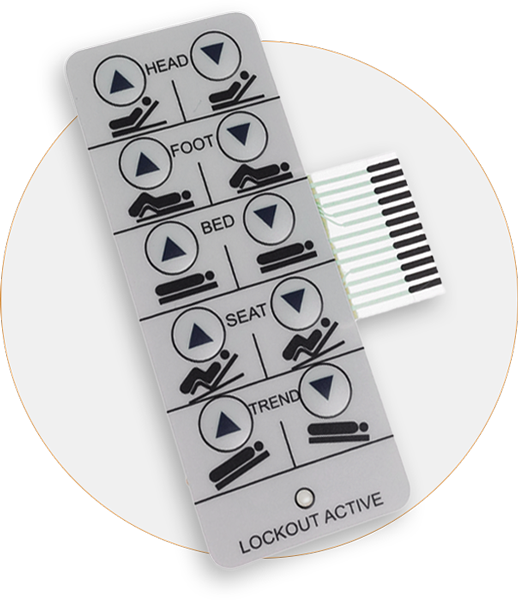The Role of a Membrane Switch in Modern Touch Interfaces and Controls
The Role of a Membrane Switch in Modern Touch Interfaces and Controls
Blog Article
Exploring the Advantages of Membrane Changes in Modern Electronic Equipment
The integration of membrane layer changes into modern-day digital equipment presents numerous compelling benefits that merit consideration. The cost-effectiveness of membrane switches positions them as a viable alternative for producers looking for to maximize their product offerings.
Style Versatility
Style flexibility is a critical advantage of membrane layer switches, allowing suppliers to produce customized user interfaces that fulfill certain functional requirements. This flexibility is important in an age where individual experience and functionality are paramount. Membrane buttons can be made in numerous shapes, sizes, and colors, enabling visual integration right into varied electronic tools.
The published graphics can be customized to match branding, while the responsive responses can be adapted to improve customer interaction. Additionally, membrane buttons can incorporate numerous layers, allowing features such as backlighting and safety overlays, which add to both visual charm and performance.
Manufacturers can also use numerous products, such as polyester or polycarbonate, to line up with details application requirements. This versatility encompasses the setup of the switch design, allowing the assimilation of several functions within a solitary user interface.
The capability to customize not only improves the use of digital tools but likewise enables the unification of sophisticated modern technologies, such as capacitive touch. Because of this, membrane layer switches are an optimum choice for a wide array of applications, ranging from medical tools to customer electronic devices, guaranteeing that customer demands are continually fulfilled.
Sturdiness and Long Life
Durability and long life are essential factors that boost the allure of membrane layer buttons in modern-day electronic tools. These buttons are designed to hold up against tough atmospheres, including direct exposure to dampness, dirt, and different chemicals. The robust materials used in their construction, such as polyester and polycarbonate, contribute significantly to their resistance against abrasion and influence, ensuring that they maintain functionality even under difficult conditions.
Furthermore, membrane layer buttons are inherently secured, protecting against pollutants from penetrating the interior components. This closed building not only prolongs the life expectancy of the buttons but additionally decreases the regularity of upkeep and replacements, which is an important aspect for suppliers and end-users alike.
Another advantage is their capability to endure substantial cycles of procedure without destruction in performance (Membrane Switch). This characteristic makes them particularly ideal for applications calling for frequent use, such as clinical devices, industrial equipment, and consumer electronics
Cost-Effectiveness

Additionally, membrane buttons are usually generated utilizing affordable materials and processes. Their lightweight style not just reduces delivery costs yet also enables much easier integration right into digital devices. This can bring about further savings in making expenses, as streamlined setting up processes decrease labor and time demands.
Furthermore, the inherent simplicity of membrane button styles often suggests less parts are needed contrasted to traditional mechanical buttons. This decrease in components not just lowers manufacturing costs yet also minimizes factors of failing, improving dependability and efficiency.
In fields where budget restrictions are important, such as consumer electronics and industrial applications, the cost-effectiveness of membrane changes ends up being particularly helpful. Their capability to supply constant performance at a lower lifecycle expense settings them as a prudent option for modern electronic devices. Generally, spending in membrane buttons can result in significant long-lasting savings for organizations and customers.
Personalization Options
Personalization options for membrane layer switches are substantial, enabling manufacturers to customize these elements to fulfill specific application demands. Among the key advantages of membrane layer switches is their convenience in style. Producers can pick from a variety of products, consisting of polyester, polycarbonate, and acrylic, each offering unique advantages in terms of resilience and visual appeals.
Additionally, membrane switches can be customized in various shapes and sizes to fit unique tool arrangements. This versatility includes the unification of various shades, graphics, and textures, making it possible for brand names to keep their aesthetic identification while boosting individual experience (Membrane Switch). Additionally, producers can integrate responsive comments functions, such as printed tricks or varying actuation pressures, to enhance functionality
Personalized circuit styles permit for certain functionalities, enabling producers to develop switches that provide precisely to their product's requirements. Overall, these comprehensive personalization options make membrane changes an engaging selection for contemporary digital devices.
Applications in Various Industries
Membrane buttons locate extensive applications across a variety of markets, demonstrating their flexibility and functionality in many setups (Membrane Switch). In the medical care industry, they are generally made use of in clinical tools, such as individual monitors and diagnostic equipment, where reliability and convenience of cleaning are vital. Their sealed style aids avoid contamination, making them optimal for settings that call for strict hygiene criteria
In the auto industry, membrane layer buttons play a critical role in control panels and control panels, supplying an user-friendly interface for drivers. The responsive feedback and personalized attributes enhance individual experience while making certain durability versus resonances and ecological variables.

Furthermore, in commercial applications, membrane layer buttons are employed in machinery control systems, enabling straight and reliable user interaction. With their adaptability, membrane layer switches use a robust option that satisfies the varied needs of today's technology-driven sectors, confirming essential for both capability and visual charm.
Verdict
In conclusion, membrane switches over offer significant advantages in contemporary digital equipment because of their style adaptability, sturdiness, and cost-effectiveness. Their capability to be tailored to meet particular branding demands, integrated with robust protection versus ecological variables, improves their suitability for varied applications. The light-weight nature of membrane switches further contributes to reduced delivery costs and convenience of combination. On the whole, these features setting membrane layer switches as a preferred option in technology-driven industries seeking to enhance use and visual appeal.
Report this page